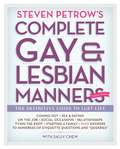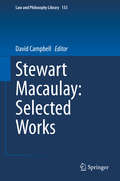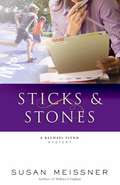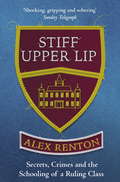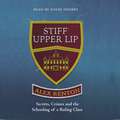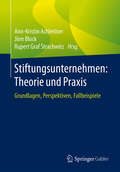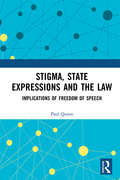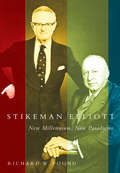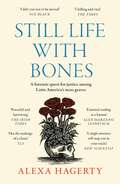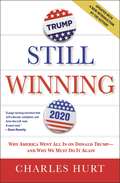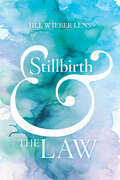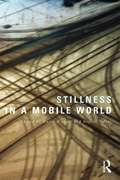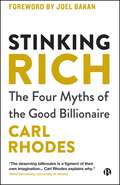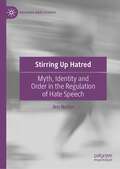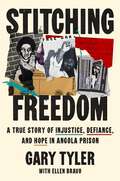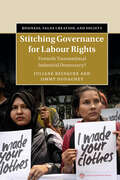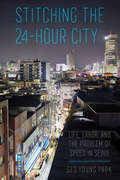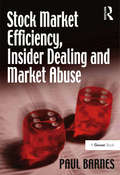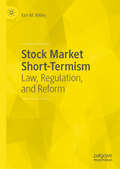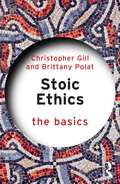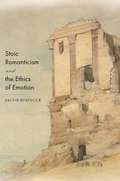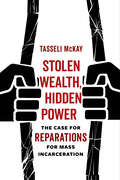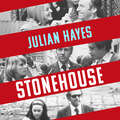- Table View
- List View
Steven Petrow's Complete Gay And Lesbian Manners: The Definitive Guide To LGBT Life
by Steven Petrow Sally ChewFinally, the first big book of manners for the more than 15 million lesbian, gay, bisexual, and transgender people in the United States and Canada and the people who love them, work with them, and live with them. Written by Steven Petrow, the go-to authority on the subject-he's the same-sex wedding expert at The New York Times and a columnist for The Huffington Post, Yahoo's Shine, GayWeddings. com, and the "Q" Syndicate (with distribution to more than 100 LGBT newspapers and websites)-this is the definitive book of LGBT etiquette. Encyclopedic in its approach, filled with practical wisdom, lively wit, and much insight, Steven Petrow's Complete Gay & Lesbian Manners covers everything: from coming out to being out in the workplace; from dealing with the joy and complexity of same-sex weddings and commitment ceremonies (including how to propose and write meaningful vows) to handling the legal paperwork every couple needs. There's a chapter on sex etiquette, and another on the challenges and opportunities of raising a family, plus sections on travel, bullying, entertaining, meeting new friends, introducing your partner to your family, a primer on gay pride, and so much more. Throughout there are hundreds of questions-some posed by LGBT folk, and others by straight people: What do the mothers of two brides wear to a lesbian wedding? What do you say to an anti-gay joke? How do you answer "Who's the father?" when there are two mothers? Manners, yes, but with a twist. **In recognition of Quality, Excellence, and Design, this ebook has been granted a QED seal of approval from Digital Book World. **
Stewart Macaulay: Selected Works (Law and Philosophy Library #133)
by David CampbellThis book represents a unique resource about Stewart Macaulay one of the common law world’s leading scholars of the law of contract and of the law in action approach to the study of law. Since 1959, he has published over 50 articles in leading journals, a number of working papers, (with colleagues at the University of Wisconsin Law School) a pathbreaking casebook for the teaching of the law of contract, and (with other colleagues) equally pathbreaking collections of materials for the teaching of the law in action or law in context approach to the study of law. In this work Macaulay has established himself as one of the postwar world’s leading scholars of the law of contract and of the sociology of law. His work is an absolute reference point in both disciplines, and it has attracted great attention elsewhere, most notably in economic sociology, where his concept of non-contractual economic relationships is regarded as an important theoretical innovation. Macaulay’s work has become an object of commentary in its own right, and the proposed book is intended to assist further such commentary by making hitherto difficult to obtain works readily accessible. Most of Macaulay’s work is now, when the leading journals are generally available in electronic form, readily accessible to students and researchers in universities. There are, however, a number of interesting and in most cases important works published in less accessible journals or works which were not published in an electronic form, which are difficult to obtain. This book will make them readily available, and in so doing will make it possible in future for scholars to have Macaulay’s complete oeuvre readily to hand. Although Macaulay’s work has provoked very considerable discussion, there previously have been no overall accounts of that work as opposed to critical engagements with aspects of it. In this book, two additional essays by leading commentators give accounts of Macaulay’s work and provide an introduction to, exegesis of and general evaluation of Macaulay’s work as a whole which is not to be found in the existing literature.
Sticks & Stones (Rachael Flynn Mysteries, Book #2)
by Susan Meissner"They're going to find a body at the River Ten-ace construction site. He deserved what he got, but it wasn't supposed to happen. It was an accident." Lawyer Rachael Flynn has only been at her new job in the Ramsey County attorney's office for four months when she receives an unsigned letter with the startling message. Two days later the predicted body is found, but to everyone's astonishment, the remains have been buried for at least 20 years. When the body is identified as that of a 15-year-old boy the police begin to dig for clues. Rachael continues to receive anonymous notes... and the questions keep coming... Was it really an accident, or was it murder? Why has it taken so many year for this story to come to light? And why did the young man "deserve" to die? As Rachael searches out the identity of the writer, she finds herself drawn to the neighborhood where the body was found-and to an abandoned house that no longer exists, but seems to call out to her
Stiff Upper Lip: Secrets, Crimes and the Schooling of a Ruling Class
by Alex Renton'A brave and necessary book' GUARDIAN'Shocking, gripping and sobering' SUNDAY TELEGRAPHNo other society sends its young boys and girls away to school to prepare them for a role in the ruling class.Beating, bullying, fagging, cold baths, vile food and paedophile teachers are just some of the features of this elite education, and, while some children loved boarding school, others now admit to suffering life-altering psychological damage. Stiff Upper Lip exposes the hypocrisy, cronyism and conspiracy that are key to understanding the scandals over abuse and neglect in institutions all over the world.Award-winning investigative journalist Alex Renton went to three traditional boarding schools. Drawing on those experiences, and the vivid testimony of hundreds of former pupils, he has put together a compelling history, important to anyone wondering what shaped the people who run Britain in the twenty-first century.
Stiff Upper Lip: Secrets, Crimes and the Schooling of a Ruling Class
by Alex RentonThis is the story of generations of parents, Britain's richest and grandest, who believed that being miserable at school was necessary to make a good and successful citizen. Childish suffering was a price they accepted for the preservation of their class, and their entitlement. The children who were moulded by this misery and abuse went on - as they still do - to run Britain's public institutions and private companies.Confronting the truth of his own schooldays and the crimes he witnessed, Alex Renton has revealed a much bigger story. It is of a profound malaise in the British elite, shown up by tolerance of the abuse of its own children that amounts to collusion. This culture and its traditions, and the hypocrisy, cronyism and conspiracy that underpin them, are key to any explanation of the scandals over sexual abuse, violence and cover-up in child care institutions that are now shocking the nation.As Renton shows, complicity in this is the bleak secret at the heart of today's British elite.Read by David Thorpe.(p) 2017 Orion Publishing Group
Stiftungsunternehmen: Grundlagen, Perspektiven, Fallbeispiele
by Ann-Kristin Achleitner Jörn Block Rupert Graf StrachwitzDieses Buch gibt einen Überblick über den State-of-the-Art zum Thema Stiftungsunternehmen in Deutschland. Das Werk dient als Basis für weitere wissenschaftliche Arbeiten ebenso wie für die praktische Orientierung in Stiftungsunternehmen selbst.Stiftungsunternehmen werden oft als "gute Kapitalisten" bezeichnet, die auf Kontinuität setzen und gemeinwohlorientiert handeln. Gleichzeitig mangelt es häufig an Transparenz und Accountability. Der Band vermittelt einen interdisziplinären Einblick in verschiedene Bereiche, von Corporate Social Responsibility und Nachfolgeplanung bis hin zur Zusammenarbeit mit Stiftungen.
Stigma, State Expressions and the Law: Implications of Freedom of Speech
by Paul QuinnThis book demonstrates the difficulties the law is likely to encounter in regulating the expressive activities of the state, particularly with regard to the stigmatization of vulnerable groups and minorities. Freedom of speech is indispensable to a democratic society, enabling it to operate with a healthy level of debate and discussion. Historically, legal scholars have underappreciated the power of stigmatization, instead focusing on anti-discrimination law, and the implicit assumption that the state is permitted to communicate freely with little fear of legal consequences. Whilst integral to a democratic society, the freedom of a state to express itself can however also be corrosive, allowing influential figures and organizations the possibility to stigmatize vulnerable groups within society. The book takes this idea and, uniquely weaving legal analysis with extant psychological and sociological research, shows that current legal approaches to stigmatization are limited. Starting with a deep insight into what constitutes state expressions and how they can become stigmatizing, the book then goes on to look into the capacity the law currently has to limit these expressions and asks even if it could, should it? This fascinating study of an increasingly topical subject will be of interest to any legal scholar working in the field of freedom of expression and discrimination law.
Stikeman Elliott: New Millennium, New Paradigms Volume 2
by Richard W. PoundIn its sixty-year existence, the Stikeman Elliott firm has played a role in many of the most significant transactions in Canadian business history, appearing before the major courts of the country in precedent-setting litigation. Its members are at the top of the legal profession and its reach is global. Clients include major foreign investors requiring advice for entry into Canada, as well as for investments in many other parts of the world. In Stikeman Elliott: The First Fifty Years, Richard Pound recounted how Heward Stikeman and Fraser Elliott developed their small law practice into a national and global organization. Here Pound details the firm's global expansion at a time of worldwide economic uncertainty. Embracing both diversity and corporate social responsibility, the organization's unwavering commitment to client confidentiality, knowledge management, and recruiting and retaining lawyers and staff of the highest quality has helped Stikeman Elliott retain its place as one of the preeminent business law firms in the country. An insightful look at recent innovations put into practice, Stikeman Elliott: New Millennium, New Paradigms offers an insider's view of a firm which has carved out an important role in Canadian legal and business history.
Still Hungry in America
by Robert ColesBefore a child is born he has already lived a life; and when he is born he comes into more than the immediate world of his mother's arms. Not all pregnant women can take food and vitamins for granted, or a gynecologist to tell them they are indeed pregnant or an obstetrician to watch them and care for them and eventually deliver them a healthy son or daughter. For that matter, not all pregnant women can take for granted clean, running water, or a home that is warm in winter and reasonably free of germ-bearing flies and mosquitoes in summer. Nor can some pregnant women forget about rats and cockroaches, or garbage that is ignored by local "authorities," or sewage that is not adequately drained away.These are American women, American mothers, American children.
Still Life with Bones: 'I defy you not to be moved' - Sue Black
by Dr Alexa HagertyAn anthropologist working with forensic teams and victims' families to investigate crimes against humanity in Latin America explores what science can tell us about the lives of the dead in this haunting account of grief, the power of ritual, and a quest for justice."Exhumation can divide brothers and restore fathers, open old wounds and open the possibility of regeneration-of building something new with the pile of broken mirrors that is loss and mourning."Over the course of Guatemala's thirty-year armed conflict -the longest ever in Central America-over 200,000 people were killed. During Argentina's military dictatorship in the seventies, over 30,000 people were disappeared. Today, forensic anthropologists in each country are gathering evidence to prove atrocities and seek justice. But these teams do more than just study skeletons-they work to repair families and countries torn apart by violence.In Still Life with Bones, anthropologist Alexa Hagerty learns to see the dead body with a forensic eye. She examines bones for evidence of torture and fatal wounds-hands bound by rope, cuts from machetes-but also for signs of a life lived: to articulate how life shapes us down to the bone. A weaver is recognized from the tiny bones of the toes, molded by years of kneeling before a loom; a girl is identified alongside her pet dog. In the tenderness of understanding these bones, Hagerty discovers how exhumation serves as a ritual in the naming and placement of the dead, and connects ancestors with future generations. She shows us how this work can bring meaning to families dealing with unimaginable loss, and how its symbolic force can also extend to entire societies in the aftermath of state terror and genocide. Encountering the dead has the power to transform us, making us consider each other, our lives, and the world differently.Weaving together powerful stories about investigative breakthroughs, grieving families, histories of violence, and her own forensic coming of age, Hagerty crafts a moving portrait of the living and the dead."Touching, but achingly honest-a most amazing account of training as a forensic anthropologist. When Hagerty talks about "lives being violently made into bones," I defy you not to be moved. The text is unflinching, but then the crimes and the victims deserve nothing less. I guarantee this will make you think long and hard about cruelty and human rights and the dedication and humanity of the forensic scientist." - PROFESSOR DAME SUE BLACK
Still Life with Bones: 'I defy you not to be moved' - Sue Black
by Dr Alexa HagertyAn anthropologist working with forensic teams and victims' families to investigate crimes against humanity in Latin America explores what science can tell us about the lives of the dead in this haunting account of grief, the power of ritual, and a quest for justice."Exhumation can divide brothers and restore fathers, open old wounds and open the possibility of regeneration-of building something new with the pile of broken mirrors that is loss and mourning."Over the course of Guatemala's thirty-year armed conflict -the longest ever in Central America-over 200,000 people were killed. During Argentina's military dictatorship in the seventies, over 30,000 people were disappeared. Today, forensic anthropologists in each country are gathering evidence to prove atrocities and seek justice. But these teams do more than just study skeletons-they work to repair families and countries torn apart by violence.In Still Life with Bones, anthropologist Alexa Hagerty learns to see the dead body with a forensic eye. She examines bones for evidence of torture and fatal wounds-hands bound by rope, cuts from machetes-but also for signs of a life lived: to articulate how life shapes us down to the bone. A weaver is recognized from the tiny bones of the toes, molded by years of kneeling before a loom; a girl is identified alongside her pet dog. In the tenderness of understanding these bones, Hagerty discovers how exhumation serves as a ritual in the naming and placement of the dead, and connects ancestors with future generations. She shows us how this work can bring meaning to families dealing with unimaginable loss, and how its symbolic force can also extend to entire societies in the aftermath of state terror and genocide. Encountering the dead has the power to transform us, making us consider each other, our lives, and the world differently.Weaving together powerful stories about investigative breakthroughs, grieving families, histories of violence, and her own forensic coming of age, Hagerty crafts a moving portrait of the living and the dead."Touching, but achingly honest-a most amazing account of training as a forensic anthropologist. When Hagerty talks about "lives being violently made into bones," I defy you not to be moved. The text is unflinching, but then the crimes and the victims deserve nothing less. I guarantee this will make you think long and hard about cruelty and human rights and the dedication and humanity of the forensic scientist." - PROFESSOR DAME SUE BLACK(P) 2023 Headline Publishing Group Ltd
Still Winning: Why America Went All In on Donald Trump-And Why We Must Do It Again
by Charles HurtLearn why President Trump is the ideal changemaker that can put an end to America's uncontrollable and corrupt system of government ruled by special interest.Still Winning is the story of the unlikeliest of heroes who emerged from the unlikeliest of places to take up the impossible cause of a truly forgotten people. They are people who love their country, trust their higher God, obey laws and will do anything for their family and neighbors. They are the very people the Founders envisioned when they hatched the radical idea of self-governance. This is the story of a Leviathan government - the most powerful political force in the history of mankind - that has become dangerously unmoored from the people it represents. It is the story of how elites and the politically comfortable controlling both parties in Washington have utterly lost touch. They don't even realize how much the people they represent despise the uncontrollable Leviathan.The establishment has tried their best to ignore Donald Trump-except to brand him as a racist, a xenophobe, an isolationist, and a dangerous, violence-inciting war monger. All standards of reporting vanished. In the era of Trump, no sort of criticism was off-limits. They openly mocked his looks, ridiculed his private business accomplishments, pilloried his family and children and made fun of his foreign-born wife for her accent!The Leviathan has grown untamable. Democrats and Republicans run for office year after year on promises they have no intention of keeping. Neither side wants to fix a single problem. The whole thing has become one giant ungovernable, corrupt Ponzi scheme that - one day - will come crashing down.Charles Hurt advocates for the "Nuclear Option" for dealing with this mess: just blow the whole damned thing up. Whatever is presidential or diplomatic, let's try the opposite. Whatever these people in Washington find most horrifying, let's try that. Finally, the multi-headed Leviathan swamp monster has met the perfect dragon slayer in Donald Trump. Still Winning examines each corrupt head of this Leviathan, and why Donald Trump is the only good answer to fixing it.
Stillbirth and the Law
by Jill Wieber LensEach year in the United States, about 1 in 170 births is a stillbirth, a rate that has remained stagnant for most of this century even as other high-income countries have dramatically reduced their already lower rates. Jill Wieber Lens, the nation’s foremost expert on stillbirth and the law, blends personal experience and legal analysis to bring us an original, essential guide to this all-too-often unrecognized public health crisis. By exposing how the law inhibits prevention, affects the experience of stillbirth for birthing parents, and shapes broader notions of unborn life, Lens argues for a series of pragmatic, data-driven changes to the legal landscape that could enjoy broad popular support and strengthen reproductive justice and reproductive rights.
Stillness in a Mobile World (International Library of Sociology)
by David Bissell Gillian FullerThis edited collection of essays on the conceptual, political and philosophical importance of stillness is positioned within a world that has increasingly come to be understood through the theoretical and conceptual lens of movement. With contributions from leading scholars in the field, the diversity of this collection illuminates the multiplicity of ontological and epistemological registers through which stillness moves: from human geography to media studies, cultural theory to fine arts. With the help of luminaries such as Deleuze, Bergson, Barthes and Beckett, this book interweaves cutting-edge theoretical insight with empirical illustrations which examine and traverse a multitude of practices, spaces and events. In an era where stasis, slowness and passivity are often held to be detrimental, this collection puts forward a new set of political and ethical concerns which help us to come to terms with, understand, and account for (im)mobile life. Stillness in a Mobile World in an essential source of reference for both undergraduate and post-graduate students working within disciplines such as cultural studies, sociology, mobility studies, and human geography.
Stinking Rich: The Four Myths of the Good Billionaire
by Carl RhodesBillionaires are an ultra-elite social class whose numbers are growing alongside their obscene wealth while others struggle, suffer or even die. They represent a scourge of economic inequality, but how do they get away with it? A set of dangerous and deceptive inter-connected myths portrays them as a ‘force for good’: - the ‘heroic billionaire’ asserts they are gallant protagonists of the American Dream gone global - the ‘generous billionaire’ pretends that their philanthropic efforts and personal good deeds should be lauded for generosity and benevolence - the ‘meritorious billionaire’ insists that extreme wealth is a worthy reward for individual hard work and talent - the ‘vigilante billionaire’ claims to be able to solve the world’s biggest problems where bureaucrats and politicians have failed. Each of these myths enables billionaire wealth and power to set us back to old-style feudalism and plutocracy. Offering a trenchant critique, this incisive book testifies to the growing international political will to take concrete actions in supporting economic justice and democratic equality.
Stirring Up Hatred: Myth, Identity and Order in the Regulation of Hate Speech (Palgrave Hate Studies)
by Jen NellerThis book critically examines the development of the ‘stirring up hatred’ offences which are currently found within the UK’s Public Order Act 1986. Through a critical discourse analysis of key excerpts of parliamentary Hansard, the book constructs a detailed genealogy of the offences from the perspectives that shaped them. A novel application of theory on 'myth' is used to navigate the complex arguments and to trace ideas about identity and order across parliamentary debates, from fears of Fascism in the 1930s to condemnations of homophobia in the early 21st century. The story of the stirring up hatred offences told in this book therefore extends far beyond the traditional frame of a dilemma between regulating hate speech and safeguarding free speech: it is inextricably entwined with myths about law, race and national identity, and speaks to wider themes of coloniality, neoliberalism, white entitlement, British-Christian exceptionalism and the innocence of law. Written in an accessible and engaging style, this book challenges a wide range of assumptions about hate speech law and raises a series of considerations for developing forms of accountability that are less complicit in the harms that they are supposed to redress.
Stitching Freedom: A True Story of Injustice, Defiance, and Hope in Angola Prison
by Gary TylerIn the tradition of books by Albert Woodfox and Angela Davis, this gripping memoir of a wrongful conviction and time spent on death row in Angola prison shows how incarcerated people care for each other and fight for justice In 1975, seventeen-year-old Gary Tyler was sent to Angola prison to die. A year earlier, he had been wrongfully charged with the killing of a white teenager and found guilty by an all-white jury, making Gary the youngest prisoner on death row in the United States Following his conviction, Amnesty International and investigative reporters documented the brutal treatment, fabricated evidence, recanted testimony, and repeated injustices that led to his sentencing. Three times Gary was recommended for a pardon; three times Louisiana governors refused to accept the political risk. After more than four decades in prison, Tyler was released in 2016—but he was never exonerated. This is not a story of mistaken identity or circumstantial evidence, but one of systemic injustice from an institution hard-wired into a legacy of slavery—in effect, this was a legal lynching. While detailing the injustice, Gary&’s memoir is also a remarkable story of pride, forgiveness, community, and triumph. With insight and heart, he shows how he learned to reject bitterness and fight for freedom, helped by activists such as Albert Woodfox and Herman Wallace on the inside and relentless support from a mass movement on the outside. Stitching Freedom is the page-turning narrative with which Gary reclaims his power.
Stitching Governance for Labour Rights: Towards Transnational Industrial Democracy? (Business, Value Creation, and Society)
by Jimmy Donaghey Juliane ReineckeTransnational labour governance is in urgent need of a new paradigm of democratic participation, with those who are most affected - typically workers - placed at the centre. To achieve this, principles of industrial democracy and transnational governance must come together to inform institutions within global supply chains. This book traces the development of 'transnational industrial democracy', using responses to the 2013 Rana Plaza disaster as the empirical context. A particular focus is placed on the Bangladesh Accord and the JETI Workplace Social Dialogue programme. Drawing on longitudinal field research from 2013–2020, the authors argue that the reality of modern-day supply chain capitalism has neither optimal institutional frameworks nor effective structures of industrial relations. Informed by principles of industrial democracy, the book aims at enhancing emerging forms of private transnational governance as second-best institutions.
Stitching the 24-Hour City: Life, Labor, and the Problem of Speed in Seoul
by Seo Young ParkStitching the 24-Hour City reveals the intense speed of garment production and everyday life in Dongdaemun, a lively market in Seoul, South Korea. Once the site of uprisings against oppressive working conditions in the 1970s and 1980s, Dongdaemun has now become iconic for its creative economy, nightlife, fast-fashion factories, and shopping plazas. Seo Young Park follows the work of people who witnessed and experienced the rapidly changing marketplace from the inside. Through this approach, Park examines the meanings and politics of work in one of the world's most vibrant and dynamic global urban marketplaces.Park brings readers into close contact with the garment designers, workers, and traders who sustain the extraordinary speed of fast-fashion production and circulation, as well as the labor activists who challenge it. Attending to their narratives and practices of work, Park argues that speed, rather than being a singular drive of acceleration, is an entanglement of uneven paces of life, labor, the market, and the city itself. Stitching the 24-Hour City exposes the under-studied experiences with Dongdaemun fast fashion, peeling back layers of temporal politics of labor and urban space to record the human source of the speed that characterizes the never-ending movement of the 24-hour city.
Stock Market Efficiency, Insider Dealing and Market Abuse
by Paul BarnesThe recent turbulence in the stock market has brought into question the way, and prices at which, shares are traded, and how the market effectively values companies. It has also raised public concern as to the way by which dealers and investors take advantage of changes in market prices. A number of high profile criminal prosecutions of insider dealing and market abuse and the frequent claims of other instances, combined with the changes in regulations resulting in a more aggressive and proactive stance by the various regulators, have brought the issue under the spotlight. This book discusses what makes stock market efficiency so important for the economy, looks at the theory and issues that underpin market abuse and why an offence often dismissed as a victimless crime is punished so severely. It explores the impact of perception and other factors that distort the market and outlines the extent of abuse. Regulators, lawyers, company officials, investigators, professional advisers and of course investors, both professional and otherwise will find this a helpful guide to the underlying elements of fraud and market manipulation.
Stock Market Short-Termism: Law, Regulation, and Reform
by Kim M. WilleyConsideration of harmful short-termism in capital markets is prevalent amongst legal and business academics. It is also garnering increased attention in corporate board rooms and executive suites, and from the investing public. As a result, correcting perceived short-termism in capital markets has become a rationale for reform used by regulators across the globe. Despite the considerable attention given to this phenomenon, there has not yet been a comprehensive book analyzing the perceived short-termism problem, its sources and causes, and reform efforts undertaken to date. This book fills this gap by documenting the rise of the short-termism discussion, analyzing the significance of the problem, and considering the proposed legal remedies. Based on this analysis, a framework for effective short-termism reform is offered.
Stoic Ethics: The Basics (The Basics)
by Christopher Gill Brittany PolatAt a time of unprecedented interest in Stoicism, this book offers a comprehensive introduction to Stoic ethics for students and for readers interested in Stoic life-guidance.It combines an explanation of the main philosophical ideas in ancient Stoic ethics by Christopher Gill with discussion of how to put these ideas into practice in our own lives by Brittany Polat.The first seven chapters examine central Stoic ethical claims and the questions raised by their claims, including: Why does our happiness in life depend solely on virtue? Is ethics grounded on nature; and, if so, does this mean human nature or the natural world? What is the connection between gaining ethical understanding and relating properly to other people? What counts as right action and how do we learn to make good decisions? What is the proper place of emotion in the good life? The two final chapters discuss the significance of these Stoic ideas for modern thought, especially for virtue ethics and environmental ethics, and the Stoic contribution to guidance on living.With a glossary of key terms and suggestions for further reading, Stoic Ethics: The Basics is an ideal starting point for anyone looking for an accessible and lively explanation of Stoic ideas and their implications for practical living.
Stoic Romanticism and the Ethics of Emotion
by Jacob RisingerAn exploration of Stoicism’s central role in British and American writing of the Romantic periodStoic philosophers and Romantic writers might seem to have nothing in common: the ancient Stoics championed the elimination of emotion, and Romantic writers made a bold new case for expression, adopting “powerful feeling” as the bedrock of poetry. Stoic Romanticism and the Ethics of Emotion refutes this notion by demonstrating that Romantic-era writers devoted a surprising amount of attention to Stoicism and its dispassionate mandate. Jacob Risinger explores the subterranean but vital life of Stoic philosophy in British and American Romanticism, from William Wordsworth to Ralph Waldo Emerson. He shows that the Romantic era—the period most polemically invested in emotion as art’s mainspring—was also captivated by the Stoic idea that aesthetic and ethical judgment demanded the transcendence of emotion.Risinger argues that Stoicism was a central preoccupation in a world destabilized by the French Revolution. Creating a space for the skeptical evaluation of feeling and affect, Stoicism became the subject of poetic reflection, ethical inquiry, and political debate. Risinger examines Wordsworth’s affinity with William Godwin’s evolving philosophy, Samuel Taylor Coleridge’s attempt to embed Stoic reflection within the lyric itself, Lord Byron’s depiction of Stoicism at the level of character, visions of a Stoic future in novels by Mary Shelley and Sarah Scott, and the Stoic foundations of Emerson’s arguments for self-reliance and social reform.Stoic Romanticism and the Ethics of Emotion illustrates how the austerity of ancient philosophy was not inimical to Romantic creativity, but vital to its realization.
Stolen Wealth, Hidden Power: The Case for Reparations for Mass Incarceration
by Tasseli McKayA meticulous and exhaustive accounting of the total economic devastation wreaked on Black communities by mass incarceration with an action guide for vital reparations.Stolen Wealth, Hidden Power is a staggering account of the destruction wrought by mass incarceration. Finding that the economic value of the damages to Black individuals, families, and communities totals $7.16 trillion—roughly 86 percent of the current Black–White wealth gap—this compelling and exhaustive analysis puts unprecedented empirical heft behind an urgent call for reparations. Much of the damage of mass incarceration, Tasseli McKay finds, has been silently absorbed by families and communities of the incarcerated—where it is often compensated for by women’s invisible labor. Four decades of state-sponsored violence have destroyed the health, economic potential, and political power of Black Americans across generations. Grounded in principles of transitional justice that have guided other nations in moving past eras of state violence, Stolen Wealth, Hidden Power presents a comprehensive framework for how to begin intensive individual and institutional reparations. The extent of mass incarceration’s racialized harms, estimated here with new rigor and scope, points to the urgency of this work and the possibilities that lie beyond it.
Stonehouse: Cabinet Minister, Fraudster, Spy
by Julian Hayes'The minister's nephew recounts an extraordinary life . . . a vivid account'HENRY DE QUETTEVILLE, Telegraph'Completely absorbing and told with huge compassion, integrity and skill'CAROL ANN LEE, author of The Murders at White House Farm and A Passion For Poison'What a book. I didn't have to turn the pages. They turned themselves I literally consumed the book in just a few hungry sittings . . . Julian Hayes is perfectly placed to tell this story, particularly it's captivating human side . . . most definitely a must read'DR SALEYHA AHSAN, filmmaker and journalist, CambridgeIn November 1974, British MP and former cabinet minister John Stonehouse walked into the sea off a beach in Miami and disappeared, seemingly drowned. Then he was found - on the other side of the world, in Australia - and his extraordinary story began to come to light: a Labour cabinet minister and a devoted family man; also in a long-term affair with his secretary, and a spy for the Czech State Security agency, who had committed fraud and attempted to fake his own death to escape catastrophic business failures. Was it a mental breakdown as he later claimed? Or were there more sinister reasons for his dramatic disappearance? This is the definitive biography of Stonehouse, written by Julian Hayes, who, as the son of Stonehouse's nephew and lawyer, Michael Hayes, is uniquely placed to tell the story of this charismatic but deeply flawed politician. As a criminal lawyer in London, Hayes has used his in-depth knowledge and experience of the criminal courts, not least the Old Bailey, where the Stonehouse trial took place, to forensically examine Stonehouse's story, including Czech defector Josef Frolík's claim that he was a spy. Hayes has unearthed secret reports in the archives in Prague written by Stonehouse's former spymasters. He has also gleaned much from family members and lawyers involved in the trial and from the trial documents and other government papers held in archives in the UK and Australia.
